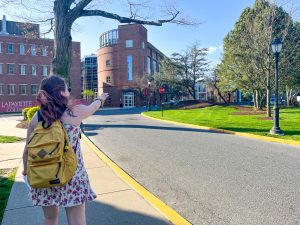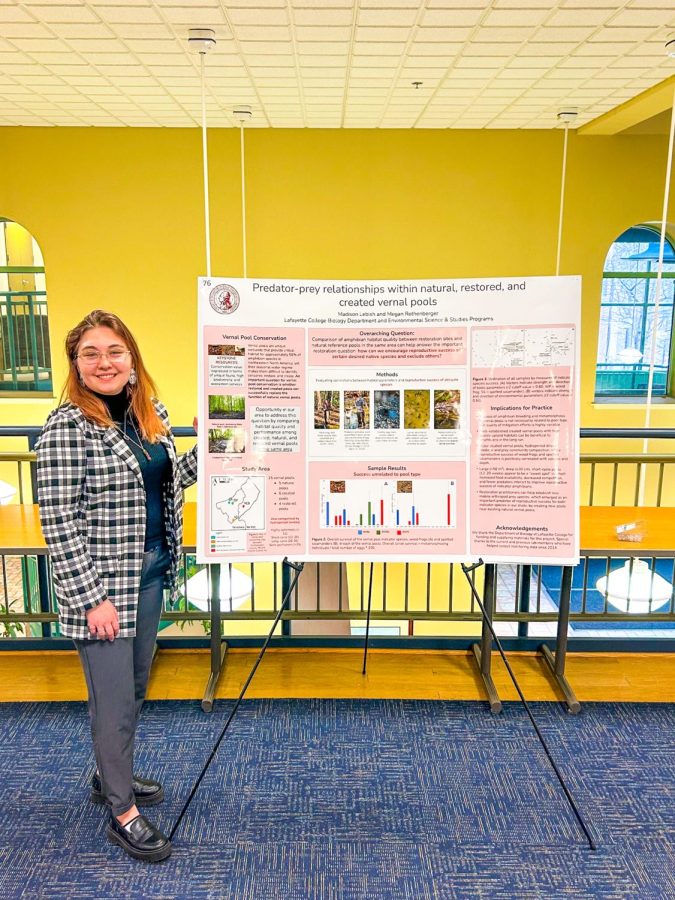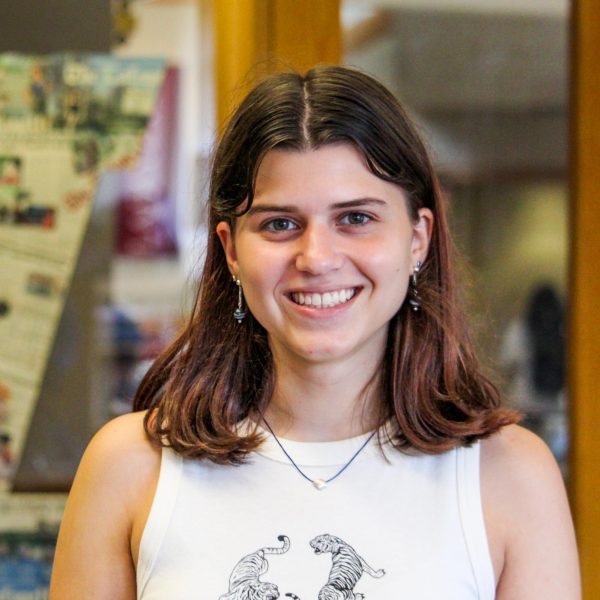With Madison Lebish ‘23 in the world, the planet just might turn out all right.
Lebish is the jack of all trades in the environmental realm at Lafayette, as she juggles two separate research projects that strive to conserve biodiversity, an issue she is particularly passionate about.
“I just think nature is beautiful, and there are so many things I want to have the opportunity to see that — if humans keep going the way that humans are going — [I] will never have the chance to,” Lebish said.
As a Biodiversity Fellow in the Office of Sustainability, Lebish is taking steps to preserve the presence of native trees on campus. Since last summer, she has taken inventory of all the trees on campus grounds.
If you have ever seen Lebish with her head in the trees, don’t be alarmed — she was likely going through the identification process of her research. Using a combination of contemplative observation, the internet and second opinions from campus groundskeepers and faculty, Lebish is able to determine the trees’ species and mark them.
With over 300 trees currently located and identified, Lebish is developing the first draft of a Lafayette tree map that is planned to launch by the end of the semester and can be distributed to audiences such as environmental classes and campus visitors. Lebish is hopeful that this documentation can eventually lead to the certification of the campus as an arboretum, a place where trees are cultivated for scientific or educational purposes.
On April 12, Lebish presented some of her findings at a talk titled “Importance of Native Plants” in honor of Earth Month, where she gave a walking tour of the native trees she marked around campus. Native trees serve an important role in supporting food webs and other connections between species, according to Lebish.
On the walk, she highlighted the beauty of the native trees on campus in hopes of breaking the stigma surrounding them.
“Oftentimes, non-native trees and plants, in general, are planted over native ones because they’re seen as more ornamental and aesthetic,” Lebish said. “There are these gorgeous aesthetic options that have so many more ecosystem services than these other [non-native] trees.”

When Lebish is not reveling in the trees, she is waist-deep in the water for her other research venture. Through the guidance of biology professor Megan Rothenberger, Lebish monitors the impact that climate change and land-use change has on vernal pools and the predator-prey dynamic within them.
A vernal pool is an ephemeral body of water that transitions between periods of drying and filling. According to Lebish, 56% of amphibians in the area utilize vernal pools during their life cycles.
“With climate change, we don’t really know a lot about how that’s affecting vernal pools and the species that rely upon them,” she said. “It’s just important to study them.”
As part of the project, which she joined in the fall, Lebish monitors 15 vernal pools within an 11-mile radius for parameters such as water quality and pool size that get added to a long-term data set. She also surveys the presence of wood frogs and spotted salamanders, the main two species that indicate vernal pool health.
In this sampling season, Lebish has discovered the impact that minimal rainfall and weather patterns have on vernal pool health and species presence.
“A lot of our pools dried up very quickly,” she said. “In the past two weeks that we’ve gone out, a lot of the egg masses are just dry.”
When Lebish was out in the field the other day, she realized her favorite part of the gig: discovering the magic that hides within the pools.
“They just look like big puddles, especially to someone who doesn’t know what they are,” Lebish said. “And there I was, almost waist-deep in a vernal pool and I see there’s egg masses, and there’s water bugs, and there’s all these tadpoles … It’s just amazing.”
Though her two research endeavors are different in practice, Lebish is often reminded of their intersections. She has learned from both projects how to strengthen her species identification skills, whether in vernal pools or on campus. Hours spent staring at eggs under a microscope or peering up at maple leaves have taught her the value of the work.
“It’s not that easy, but when it’s stuff you really care about, you take the time to learn it,” Lebish said. “I care a lot about biodiversity and conserving biodiversity, and both projects have a lot to do with that.”
Wherever Lebish ends up, she knows that she wants to be outside, continuing her role as a crusader of environmental conservation. After graduation, she will pursue a fellowship with the National Audubon Society at the John James Audubon Center, focusing on native plants and environmental education.
“It’s so important to just spend time outside and be aware of your surroundings for a couple minutes a day,” Lebish said. “You’ll never know what you’ll learn.”






































































































